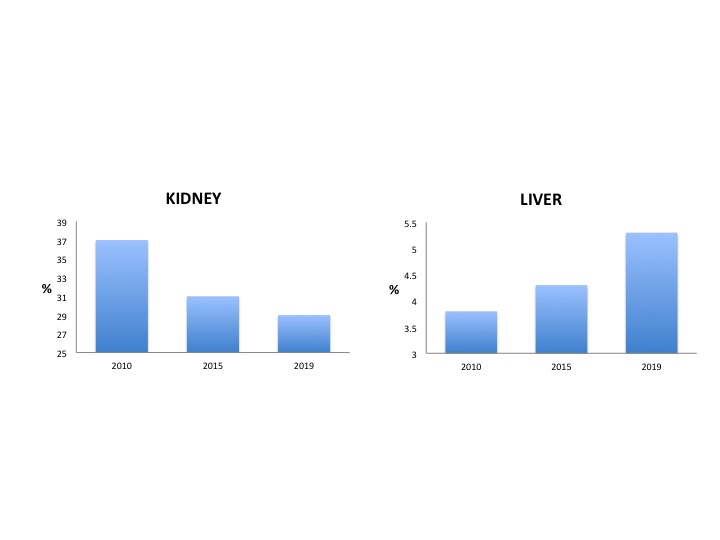Trends in Living Donor Transplantation in USA
Tampa General Hospital, Tampa, FL
Meeting: 2021 American Transplant Congress
Abstract number: 693
Keywords: Allocation, Living donor
Topic: Clinical Science » Public Policy » Non-Organ Specific: Public Policy & Allocation
Session Information
Session Name: Non-Organ Specific: Public Policy & Allocation
Session Type: Poster Abstract
Session Date & Time: None. Available on demand.
Location: Virtual
*Purpose: Globally, living donation has improved access to organ transplantation and saved the lives of individuals with end-stage kidney disease and end-stage liver disease. In the USA, the increasing prevalence of end-stage disease has resulted in widening gap in organ supply and demand. In the last decade, several allocation policies have been implemented by UNOS (United Network for Organ sharing), with the goal of maximizing donor availability, improving access and expanding the donor pool. However, the contribution of living donation on the donor pool is uncertain. Therefore, the Aim of this study is to evaluate the trend of living donation in the changing landscape of Abdominal Transplantation.
*Methods: Using the UNOS database, we identified all adult candidates (> 18 years) who underwent solid organ transplant (Liver, Kidney) in the last decade (2010 – 2019). Data extracted included Type of Transplant (Living vs. Deceased), Recipient demographics including age, gender, ethnicity and race. Chi-square tests and ANOVA tests were used for comparative analysis.
*Results: During the study period, 244,844 underwent transplant (178,125 Kidney and 66,719 Liver). Among the Kidney recipients 31.8% were living donor with 62% male and among Liver recipients 4.0 % were living donor with 55% male. Although overall there was an increase in total annual transplant (living and deceased) for both kidney (16,152 to 23,641) and liver (5731 to 8,345), there was a significant variation in proportion of living donor transplantation. We found a decline in living donor kidney transplant (LDKT) but a paradoxical increase in living donor liver transplant (LDLT). See Figure 1. With the exception of Asian group, a significant decline in LDKT was found among non-Asian (Black, Caucasian and Hispanic) in comparison to an increase in LDLT recipients. Among Asian recipients we found an increase in LDKT (27% to 33%, p=0.005) but a trend towards a decline in LDLT though this was not significant (4.1 % to 3.6%, p= 0.62).
*Conclusions: The current study showed that in the last decade (2010 – 2019), there has been a significant decline in adult LDKT with a corresponding relative increase in LDLT. With the ongoing shortage of available deceased donors and the proven comparable outcomes with living donor transplantation (liver, kidney); future studies focused on identifying barriers to living donation are warranted. Furthermore, public health policies aimed at increasing awareness and education about living donation will be invaluable
To cite this abstract in AMA style:
Kemmer N, Albers C, Agrawal S, Syed R, Malespin M, Buggs J. Trends in Living Donor Transplantation in USA [abstract]. Am J Transplant. 2021; 21 (suppl 3). https://atcmeetingabstracts.com/abstract/trends-in-living-donor-transplantation-in-usa/. Accessed December 29, 2025.« Back to 2021 American Transplant Congress

